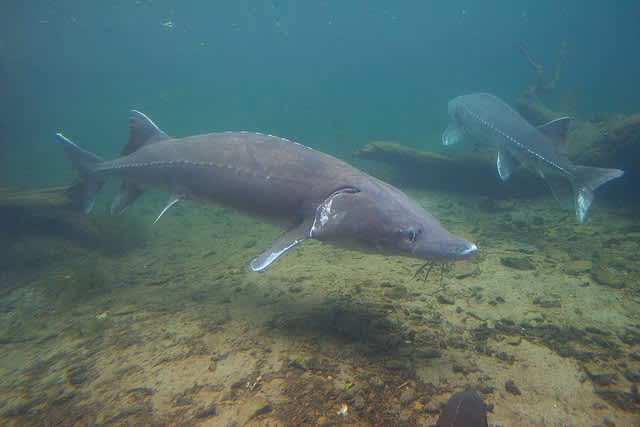Rock and Roe? Sturgeon Sing While Spawning
OutdoorHub Reporters 03.21.12

As the winter, and now spring, warms to record-setting temperatures and brings all things in the wild out of their wintry state, lake sturgeon in Wisconsin are no exception. The earliest-on-record sturgeon spawning season has apparently begun, according to the Wisconsin Department of Natural Resources (DNR).
Sturgeon spawning is dependent on water and flow, according to DNR biologists. But some Wisconsin biologists are experimenting with audio frequencies to encourage sturgeon spawning in waters were sturgeon population is depleted. Read below for the full story on the low-frequency noise sturgeon emit when spawning.
Original report issued by Great Lakes Echo on March 21st, 2012
By: Alethia Kasben
How does a scientist use sound to save a 150-million-year-old fish?
In Wisconsin, Ron Bruch and Chris Bocast are trying to help restore sturgeon stock by listening for the sound they make when spawning that some call “thunder.” The sound can be heard here.
 “It’s a real low frequency, you can almost feel it instead of hear it,” said Bruch, fish supervisor with the Wisconsin Department of Natural Resources. “One of the important measures of success is knowing your stock is spawning.”
“It’s a real low frequency, you can almost feel it instead of hear it,” said Bruch, fish supervisor with the Wisconsin Department of Natural Resources. “One of the important measures of success is knowing your stock is spawning.”
Bocast, a University of Wisconsin-Madison doctoral student in acoustic ecology, discovered the sound while working on an audio book about sturgeons. The sound they make is well below human hearing, with a frequency of 6 hertz.
“The literature kind of predicted fish in those shallow water environments would not be making sounds below 50 hertz,” he said. “It was a thrill because it was a scientific discovery for me.”
Bocast is a singer and guitarist who still records. After playing in various bands, his musical interest led him to study acoustic ecology.
Acoustic ecologists can study many things, Bocast said. Some study noise and how it affects a person’s nervous system. Others study how animals perceive sound and music in their lives.
It’s a field that tends to attract musicians.
“A lot of the people who are leading lights in the field had a career path quite similar because that is where you learn a lot about sound,” Bocast said. “As you get older, you mature and start thinking more deeply about sound and how this all related to the environment and people.”
Discovering the nature of sturgeon sounds will help when trying to restore the species, Bocast said. Previously researchers believed sturgeon simply liked spawning on smooth rock.
“But there is an acoustic property, because flat smooth rocky surfaces reflect sound,” he said. “This probably helps them in hearing the sound and successfully spawning.”
Republished with permission by greatlakesecho.org.

